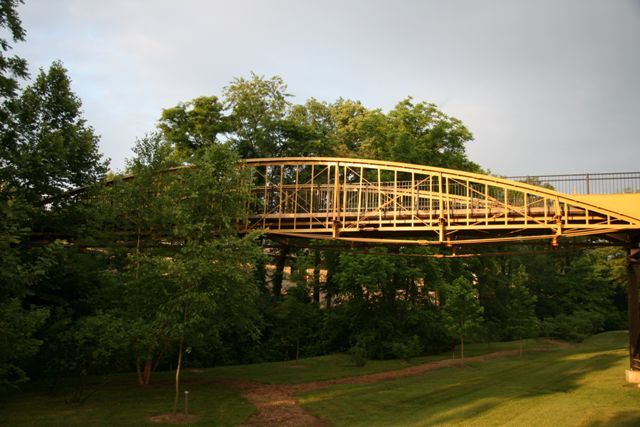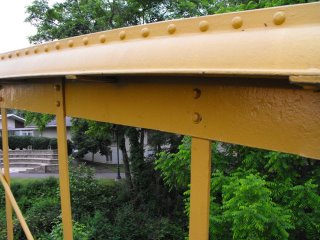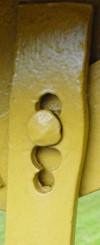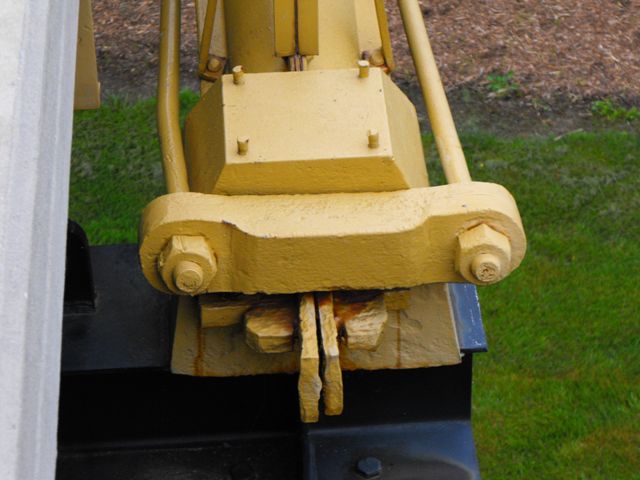We Recommend:
Bach Steel - Experts at historic truss bridge restoration.
BridgeHunter.com Phase 1 is released to the public! - Visit Now
Henszey's Wrought Iron Bridge
Mosser's Bridge

Primary Photographer(s): Nathan Holth and Rick McOmber
Bridge Documented: June 1, 2010
Summerdale: Cumberland County, Pennsylvania: United States
1869 By Builder/Contractor: Continental Bridge Company of Philadelphia, Pennsylvania and Engineer/Design: Joseph G. Henszey
2002
92.3 Feet (28.1 Meters)
92.3 Feet (28.1 Meters)
18 Feet (5.49 Meters)
1 Main Span(s)
Not Applicable

View Information About HSR Ratings
Bridge Documentation
View Historic American Engineering Record (HAER) Documentation For This Bridge
HAER Drawings, PDF - HAER Data Pages, PDF
Visit The Central Penn College Website
View The Original Patent For This Historic Bridge Design
View The Original Phoenix Column Patent
View A Historical Article About A Different, Long-Lost Henszey Bridge
About This Bridge

Henszey's Wrought Iron Bridge is a bowstring arch/truss type bridge. The bridge was originally part of a bridge built in 1869 that had two bowstring spans built to carry Main Street over Trout Creek in Slatington, Pennsylvania. When that bridge was replaced, one of the spans was salvaged and moved a second time in 1900 to Wanamakers, Pennsylvania to span Ontelaunee Creek. It stood here until 2002, when it was moved off of its abutments, restored, and brought to the Central Penn College location where it serves as a pedestrian-only connection between the second story of the Technical Learning Center building and an area of student housing which would otherwise be separated from the building by a small bluff. The relocation and restoration of the bridge was initiated by Todd Milano, the president of the college, who saved this historic bridge from demolition by acquiring the bridge through PennDOT's bridge marketing program which is a program conducted in accordance with federal Section 4(f) regulations, which states that an agency must offer a historic bridge slated for replacement to a third party for relocation and preservation.
The bridge has been known by many names over its history, including Mosser's Bridge, Allemaengel Road Bridge, Billig Bridge, and most recently, Henszey's Wrought Iron Bridge.
Historical and Technological Significance
Iron bowstring arch/truss bridges are one of the rarest types of historic bridges in the country, and are also among the oldest metal bridges in the country as well. With an 1869-1870 construction date, the Henszey's Wrought Iron Bridge is particularly old, even among iron bowstrings, with most surviving examples built between 1870 and 1880. All members and chords are wrought iron, but there are also cast iron components for the bridge's connections, floorbeams, and bearings. The cast iron components increase the rarity and significance of the bridge. Also, the use of the rare patented Phoenix type column sections on the top chord increases the significance. Most importantly however, the is nationally significant as the only known remaining bridge in the entire country that is associated Joseph Henszey.

Henszey's Wrought Iron Bridge significance is only increased by the fact that the bridge closely follows the design of a bridge outlined in a patent that Henszey held. The bridge contains all the essential details outlined in the patent. These details form a bridge with a bizarre appearance and design that is unlike any other known bowstring. The bridge contains a extremely large number of vertical members which are little more than long, narrow metal plates, and these are spaced very closely to each other. The top chord is also extremely unusual, yet extremely creative, designed to meet the needs of the bridge design. As specified in the patent, it is composed of two quarters (or sections) of a Phoenix column, which are riveted to a plate. This use of Phoenix sections is highly unusual, since normally four quarters of the Phoenix column are riveted together to form the traditional tube as shown in the original Phoenix Column patent. Aside from the unusual use of Phoenix sections, the creative part of the design is that this plate portion of the top chord doubles as a gusset plate to which the vertical members are riveted. Other unique features not specifically shown in the patent that are still noteworthy include the floorbeams which include rolled beams along with cast iron blocks which hole rods that form a kingpost design that increases the strength of the floorbeams. Also, the bottom chord is extremely strange, and is composed of two arched segments that have a bow-like shape that each almost seem to be a smaller reflection of the main arched top chord's shape.
Henszey's work and patents seem to have been partially influenced by another engineer, Thomas Moseley. Like Henszey's Bridge, there is only one remaining example of Moseley's work, which is the Hares Hill Road Bridge. While there is no single patent that reflects the exact design of the Hares Hill Road Bridge, three patents made by Thomas Moseley are related to Moseley's bowstring bridge work. One, dating to 1870, just after this bridge was built has the most related designs. There were some other bridge patents that Moseley filed that may have inspired the design of this bridge and the 1870 patent that displays the most similar details to the Hares Hill Road Bridge, one dates to 1866 and the other dates to 1857. These patents may have served to influence Henszey's work.
Bizarre Fabrication Problems

The durability and longevity of surviving metal bridges built in the United States from the 1800s is truly impressive. The ability of these bridges to defy time itself in a way that no modern bridge today can is due to a variety of reasons. The wrought iron used during this period was actually more rust-resistant and long-lasting than the steel used today. Some bridges were overbuilt by engineers who may have not been able to calculate the design of a bridge, while in contrast others may have been designed by engineers who were very skilled and creative and were able to come up with a bridge design that was uniquely effective. After design, skilled craftsmen would carefully fabricate the parts for these bridges, producing a well-built structure that would be ready to stand for over a century. All of these types of things might be applicable to the long life that Henszey's Wrought Iron Bridge has enjoyed, however some might find cause to question the skills of the craftsmen who fabricated this bridge. On old truss bridges it is not uncommon to find a few poorly formed rivets on the bridge. For example, a rivet head might have moved during hammering and thus does not line up with the hole perfectly. However, Henszey's Wrought Iron Bridge has more than just a few slightly misaligned rivets. This is a bridge that is truly fun to look at up close and try to discover all the things that didn't turn out quite right for the workers who fabricated the bridge. There are some amazing screw-ups on the bridge, some of which are normally unheard of to remain on a bridge actually erected and placed into service. On one of the verticals of the bridge, it took no less than four holes (and of different sizes!) to get the correct hole drilled for the river! The rivet they finally got into that hole also has a crude almost hand-hammered look to it. See the photo to the left. Other rivets were a disaster. The photo on the right is perhaps the worst one. The head is so far off alignment that the shank of the rivet if visible through the hole. It is unclear why there are all these problems in the bridge, whether the workers were maybe unskilled or just plain lazy. However, as bad as these problems are, its hard to be critical of the bridge or its builders given that despite these issues, the bridge still stands today and is over 140 years old.

More Than Just A Crossing: An Identity

For many years following the relocation and restoration of the Henszey bridge on campus, Central Penn College (then Central Pennsylvania College) made the bridge the true center of the college. The official logo for the college featured the bridge on it and the motto for the college was "Your Bridge To Success." The bridge also appeared in photos on the official website for the college. In this way, the college so perfectly demonstrated why reusing historic bridges is so much more special that buying a boring, undistinguished prefabricated mail order bridge like so many that dot this nation's trailways, sidewalks, and golf courses. The irony is that one of the leading producers of these mail order bridges was also called Continental Bridge Company, although today it is a part of Contech. The two Continental Bridge Companies were never related however. However, instead of buying one of these mail order Continental Bridges, the college instead opted for a historic bridge built by different and far more fascinating Continental Bridge Company! As a result, the college got a unique landmark that provided the groundwork for a truly unique yet appropriate theme for the college's goal of providing students a way to cross into a new stage in life.

Central Penn College president Todd Milano always uses the historic bridge during new student orientations as a symbol to describe a path the new students could follow to achieve their goals in life and at the college. His analogies draw connections not only to the bridge as a whole, but also the function of the parts on the bridge. He also owns a car which is painted to advertise the college and has the bridge prominently featured.

In 2010 however, the role of the bridge as the identity for the college was reduced somewhat when the college decided to redesign its entire brand. The college changed its name from Central Pennsylvania College to Central Penn College. The unique "Your Bridge To Success" slogan was replaced with a more generic "You Can. You Will" slogan and similarly the distinguished bridge logo for the college was changed to an abstract circle or globe-like symbol. These changes seem to have been made because the college has grown and created two new campuses in different locations, making the bridge theme less logical for these new campuses. The bridge's influence to the spirit of the college does still live on however, as it continues to appear in the background of numerous college photos and videos, and the bridge continues to offer a beautiful and functional connection on campus, a unique landmark that no other place in the country has.
The Henszey Plaque

During a search on the Internet, HistoricBridges.org found a bridge plaque with the Henszey name on it for sale in an Ebay auction. Given the rarity of any bridges involving Henszey, it is likely this was one of the only plaques in existence. A plaque like this deserved to be in a museum or on display to the public somewhere. With this thought in mind, HistoricBridges.org contacted Todd Milano, the president of Central Penn College, to this plaque and suggested if he wanted to buy the plaque it might make a nice display in one of the college's buildings, given that a Henszey bowstring truss is the centerpiece to the college. He agreed, and ended up buying the plaque, and he plans to restore the plaque and put it on display in the college.
HistoricBridges.org does not approve of the selling or auction of historic bridge plaques and believes that these historic artifacts should be donated to museums or otherwise placed in a publically accessible areas. In many cases, bridge plaques are stolen public property and should not be privately held in the first place. Unfortunately, there is often little that can be done to deal with these problems. In this case, there was a happy ending since the plaque will be placed in a location where the public can view it.
This bridge is tagged with the following special condition(s): Phoenix Columns and Reused
![]()
Photo Galleries and Videos: Henszey's Wrought Iron Bridge
Structure Overview
Original / Full Size PhotosA collection of overview photos that show the bridge as a whole and general areas of the bridge. This gallery offers photos in the highest available resolution and file size in a touch-friendly popup viewer.
Alternatively, Browse Without Using Viewer
![]()
Structure Details
Original / Full Size PhotosA collection of detail photos that document the parts, construction, and condition of the bridge. This gallery offers photos in the highest available resolution and file size in a touch-friendly popup viewer.
Alternatively, Browse Without Using Viewer
![]()
Structure Overview
Mobile Optimized PhotosA collection of overview photos that show the bridge as a whole and general areas of the bridge. This gallery features data-friendly, fast-loading photos in a touch-friendly popup viewer.
Alternatively, Browse Without Using Viewer
![]()
Structure Details
Mobile Optimized PhotosA collection of detail photos that document the parts, construction, and condition of the bridge. This gallery features data-friendly, fast-loading photos in a touch-friendly popup viewer.
Alternatively, Browse Without Using Viewer
![]()
Maps and Links: Henszey's Wrought Iron Bridge
Coordinates (Latitude, Longitude):
Search For Additional Bridge Listings:
Bridgehunter.com: View listed bridges within 0.5 miles (0.8 kilometers) of this bridge.
Bridgehunter.com: View listed bridges within 10 miles (16 kilometers) of this bridge.
Additional Maps:
Google Streetview (If Available)
GeoHack (Additional Links and Coordinates)
Apple Maps (Via DuckDuckGo Search)
Apple Maps (Apple devices only)
Android: Open Location In Your Map or GPS App
Flickr Gallery (Find Nearby Photos)
Wikimedia Commons (Find Nearby Photos)
Directions Via Sygic For Android
Directions Via Sygic For iOS and Android Dolphin Browser
USGS National Map (United States Only)
Historical USGS Topo Maps (United States Only)
Historic Aerials (United States Only)
CalTopo Maps (United States Only)




